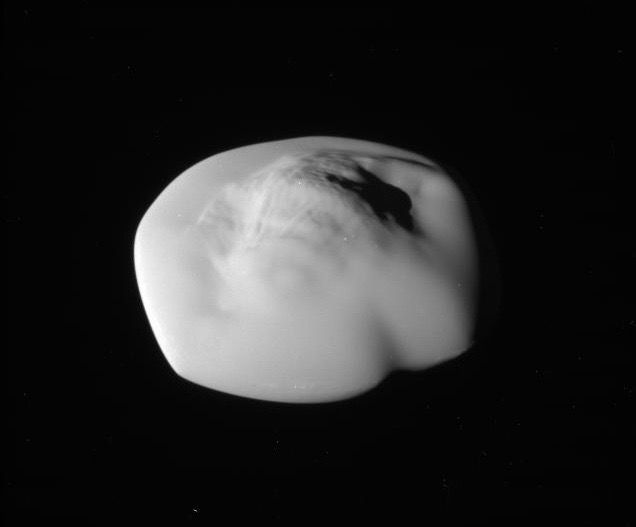

Atlas was ordered by Zeus to uphold the vault of the sky after the defeat of the Titans. Cassini images revealed in 2004 that a temporary faint ring of material with the orbit of Atlas. Like Pan, Atlas has a distinctive flying saucer shape created by a prominent equatorial ridge not seen on the other small moons of Saturn. Originally designated S/1980 S28, this moon is named after Atlas, a Titan, and a son of Iapetus. Atlas is an inner moon of Saturn, orbiting around the outer edge of Saturns A Ring. Conventional theory proposes that Atlas and Pan formed through a process of accretion, originating as pieces of space debris captured by Saturn’s gravity. The moon orbits Saturn every 13.8 hours from an average distance of 134,000. After accurately predicting the moon's orbit, Pan was found in 11 images taken by Voyager 2 during its August 1981 flyby. But as many new moons were discovered, scientists began selecting names from more mythologies including Gallic, Inuit, and Norse stories. Atlas appears to act as a shepherd moon, and, along with Pan, are Saturn’s innermost moons, keeping to the A ring, sharpening the edges of the ring and maintaining its width. Showalter and colleagues first inferred the tiny moon's presence by the waves it kicked up in the wake of its passage through the Encke Gap. Moons of Saturn were originally named for Greco-Roman Titans and descendants of the Titans. It orbits 85,544 miles (137,670 km) away from, taking 14.4 hours to complete its trip around the planet. The small, pointy moon has a mean radius of 9.4 miles (15.1 km). OverviewĪtlas is an inner moon of Saturn, orbiting around the outer edge of Saturn's A Ring. Equatorial ridges are a feature of at least three of Saturns moons: the large moon Iapetus and the tiny moons Atlas and Pan. Terrile and the Voyager 1 team from photographs taken during its encounter with Saturn. Pan and Atlas cause weak, linear density waves in Saturns rings that have yielded more reliable calculations of their masses. The Heritage, used with the 8-24 Seben zoom and the Baader 2,25x Barlow, showed between mags of 130 - 183x once again it's qualities, giving very crisp contours of the lunar structures( along with the pleasures of easy setup, handling and tracking).Atlas was discovered in 1980 by R. Encouraged, I tried to spot the fainter Rimae Secchi, but after 15 minutes of acute searching, I gave up. The Cauchy rille (Rima C.), almost parallel to the fault, was clearly fainter and seen best in it's NW part. The fault is similar to the more famous "Straight Wall" in Mare Nubium. ( I missed the two pancake-shaped domes S of the fault, as I discovered later when studying the 21st century Atlas of the Moon). Keck Observatory telescopes on the summit of Mauna Kea, Hawaii, have been amazed to find a group of dwarf galaxies moving in unison in the.
#Saturn moon atlas pancake full
To the NW, framing the 12 km crater Cauchy, the Cauchy fault (Rupes Cauchy) could be made out easily in it's almost full length, starting near V Cauchy and extending (120 km) to the end near Sinas H and J. Astronomers using the Canada-France-Hawaii and W. This crater (56 km L 31) revealed several concentric structures on it's floor, rilles and mountains. Dorsa Cato, very distinct as well, led me to Taruntius. (Was lucky enough to witness the whole totality of the eclipse of the 27th, and to share the telescopic views with other interested people (along with views of Saturn and Mars) a nice celestial present for my 66th birthday btw.) This morning, with average seeing, Messier/A showed very plastically close to the terminator. Short unplanned "ordinary" moon observation this morning (03.50 - 04.30 CEST) with the 5.1" f/5 Heritage Flextube.


 0 kommentar(er)
0 kommentar(er)
